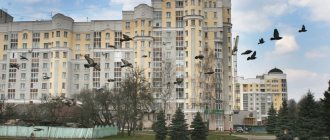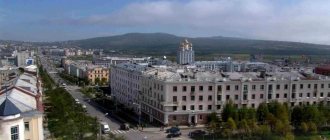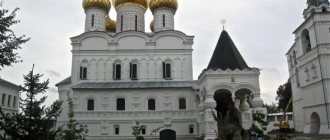Voronezh is one of the central cities of the European part of the Russian Federation, having the status of the administrative center of the Voronezh region. The settlement, located more than 500 kilometers from the capital of Russia, in 2013 exceeded the “million” population figure. Voronezh is considered the real homeland of our country's regular navy, as well as the base for airborne divisions.
On the territory of the city, which bears the title of “City of Military Glory,” in addition to numerous architectural monuments, there are many economic facilities, industrial enterprises and administrative buildings. Developed infrastructure contributes to the growth of residents’ well-being and also affects the population: in recent years, the Voronezh region has been under the close attention of thousands of migrants. In this article we will talk about the population of Voronezh, and also take a closer look at some demographic factors from official statistics.
Current statistics
According to data established by the unified interdepartmental information and statistical system, the population of Voronezh in 2021 reached 1,058,261 people. The natural increase in the city's population has been observed since 2010: in 2003, the figure was 847,620 people, and by 2021 it increased almost 1.2 times - to 1,039,801 people. In 2013, Voronezh received the title of a millionaire city, although, de facto, the regional center reached the population figure of one million inhabitants by the end of 2012.
Voronezh is one of the 20 largest cities in the Russian Federation, occupying 13th place on the list, just above Perm. It is worth saying that there is a constant “demographic struggle” between these two regional centers, which Voronezh won in 2019, albeit with a minimal margin of 173 people.
Religion and culture of the people
The population of Voronezh is 98% Orthodox. The local diocese has existed for about four centuries. Its initial goal was to fight schismatics. Bishop Mitrofan became the first head of the church at the end of the 17th century. Under him, the shrine reached unprecedented heights: not only the cathedral, but many other temples were built.
Today there are several Orthodox churches in the city. Also, among other shrines, one can note Old Believer and Baptist churches, the Jewish community, Lutheran and Catholic parishes, etc. Modern Voronezh is considered the cultural center of the entire region. Not only theatrical art, but alternative youth trends are rapidly developing here. The city has dozens of museums and galleries, several cinemas, a circus and a philharmonic society. All-Russian and international festivals and forums are held annually. 6 state universities oversee the education of the younger generation. In addition, in 2021 the city received the right to host the FIFA World Cup.
Data by year
Data on the current number of residents of Russia’s major demographic centers is publicly available. You can view such information on the official website of the Rosstat service. Also, data on the population of a particular city is indicated on the portal of the Unified Interdepartmental Information and Statistical System (EMISS). For your convenience, we considered data from both verified sources and, after a little analysis, provided the averages in the following table. The list shows the number of residents in recent years.
| Number of inhabitants (people) | Years |
| 1 023 570 | 2015 |
| 1 032 895 | 2016 |
| 1 039 801 | 2017 |
| 1 047 549 | 2018 |
| 1 054 111 | 2019 |
| 1 058 261 | 2020 |
According to data established as of January 1, 2021, Voronezh is in 13th place in terms of population among all cities of the Russian Federation. Fourteenth place is occupied by Perm (1,055,397 people), and twelfth place by Krasnoyarsk (1,093,771 people). The first and second places are held by two capitals - Moscow and St. Petersburg, 12,678,079 and 5,398,064 people, respectively.
About the city
Voronezh is the largest city, one of the regional centers of the Russian Federation. The settlement, built along the banks of the river and reservoir of the same name, has a special provincial charm. Despite the fact that the region is located away from traditional tourist routes, Voronezh still has something to show its guests.
A special part of the city’s history is dedicated to the times of the Great Patriotic War. Today it is a regional one, and on its territory you can find dozens of architectural monuments indicating that difficult time for our country. Militarist objects also include buildings operating in the shipbuilding industry. Even Peter the Great called the city the center of Russian shipbuilding - the city is home to most of our country's regular fleet.
In addition to industrial and economic facilities, the administrative center is full of all kinds of parks, restaurants, cafeterias and hotels. Tourists and residents love to visit aquariums, circuses, zoos, and also pay some attention to ancient temples and monasteries.
Description of the region
Voronezh is located at the confluence of the Don Plain and the Central Russian Upland. A significant part of the area is occupied by forest-steppe. Two large rivers flow through the city - Voronezh and Don.
Geographic time zone – UTC +3:00. By international standards, the region is located in the MSK time zone, that is, on a par with Moscow. The climate in the region is moderate. Winters are mostly frosty, but not as cold as in the capital. Snow cover is stable throughout half of the season. Frosts often occur at the beginning of November. In December, thaws occur quite often, which are accompanied by rain. The average temperature in winter is about -10 degrees. As for the summer season, it is hot and dry. The rainy season begins only in autumn. In spring there is a long period of ice drift. Thanks to the mild climate, the city is decorated with dozens of parks and squares. The local arboretum is popular among residents and tourists.
National composition
The ethnic composition of the Voronezh region is extremely diverse. This state of affairs is established due to factors of the historical settlement of the earth, as well as as a result of modern migration movements. Voronezh region is a multinational region. This statement can be supported by the statistics provided.
| Nationality | Number (persons) |
| Russians | 2 239 524 |
| Ukrainians | 73 716 |
| Persons who did not indicate nationality | 11 857 |
| Armenians | 8 813 |
| Belarusians | 5 013 |
| Tatars | 3 486 |
Please note: the overall population figure is not comparable to the data shown in this table, as not all city residents participated in the survey regarding their ethnicity. The census was carried out using modern information, statistical and technological methods.
Gender and age
The total population of the Voronezh region in 2021 exceeded 2.3 million people, and 1.5 million consider themselves to be citizens - residents of the regional center. At the same time, for every 100 girls born, on average there are 108 boys born.
Among city residents, the percentage of the female population is higher compared to the same indicator for citizens living in rural areas (54.3% versus 53.1%). By mid-2021, there are almost 1.2 thousand women for every 1,000 men. A similar trend is observed throughout Russia; the demographic table with a gender division repeats similar structures for other large cities in the country.
Data for the Voronezh region
Natural increase
Natural population growth is a key factor in demographic statistics, indicating the excess of birth rates over deaths. Simply put, it is the difference between the number of people born and died over a certain time period. Natural population growth intensified at the beginning of 2010. Since then, the city has been growing steadily, gaining new positions in the ranking of the most densely populated centers in the country.
However, upon closer examination, it turns out that the increase in population figures depends solely on migration processes. In 2021, the decline in the number of residents of Voronezh increased by 10.9%, reaching the level of 2015. Thus, the rate of population decline in Voronezh in 2021 is 11.75 thousand people. The migration increase over the same period was 10.1 thousand.
Voronezh region
Leninsky district
The central location, the lack of land free from development and the high population density are the key differences between the Leninsky district and the rest. The Voronezh-Don watershed, running approximately along the streets of Ostrogozhskaya, Krasnoznamenaya, Koltsovskaya, divides the area into eastern steep and western flat parts. The eastern part, which is a typical steep right bank, is characterized by an abundance of gullies that shaped the character of the area's development. The largest beams can be named by the streets running along their bottom: st. Bolshaya Streletskaya, st. People's militias - Jasminny lane, st. Onezhskaya. The western flat part, unlike the eastern part, has slight elevation differences. It is worth noting only the beam in the southwestern part, which covers Journalists Street and Lane. Korpusnaya, as well as Artillery and Karelian streets.
The nature of the development of the Leninsky district was largely influenced by the nature of the area. For the most part, all the beams are occupied by the private sector, and the flat areas are built up with multi-story buildings. The main transport arteries run either along the interbeam ridges or perpendicular to the beams.
Migration
The Voronezh region is a territory that has traditionally been under close attention from legal and illegal migrants. Voronezh is one of the 15 most attractive cities for migration in post-Soviet Russia. The overall increase in the number of migrants is ensured by indicators within the country (about 20%) and the factor of international migration (the remaining 80% of the total number of migrants). According to statistics, the region successfully competes for the density of migration flows with Moscow, as well as the Lipetsk and Rostov regions. A large percentage of migration comes from Ukraine, Uzbekistan and Kazakhstan.
Data for the Voronezh region
Positive migration indicators provide closure to the problem associated with a stable decline in the number of residents. Although natural growth rates are growing, they are not in a positive phase, representing a figure of minus 10.9%. In 2020, Voronezh experienced a loss of 11,075 people, while migration flows provide an increase of at least 10,000 people.
Population of Voronezh districts
There are 6 urban districts in Voronezh that do not have the rights of municipalities in accordance with the city charter. The executive and administrative authorities are district councils. Heads of district administrations are appointed by the head of the city in agreement with the city duma. Two densely populated districts (Zheleznodorozhny and Levoberezhny) are located on the left bank of the Voronezh reservoir, the rest are on the opposite (Leninsky, Kominternovsky, Sovetsky, Central).
The largest district of Voronezh in terms of population is Kominternovsky. It is home to 273,243 people or about 27% of the total population. The second largest district is the Left Bank district, which is home to 170,300 (19%) people.
The Sovetsky district is home to 143,100 (16%) residents. The next district of Voronezh in terms of population is Leninsky with 134,000 (15%) residents. It is almost completely built up, the number of residents is practically not growing. 131,000 (14%) people live in the Zheleznodorozhny district, the largest by area. The smallest district of Voronezh in terms of population is home to 82,000 (8%).
Forecast
Various services and private companies are engaged in demographic forecasting on the territory of the Russian Federation. Almost all institutions clearly point to the following picture, which will most likely be observed in Voronezh in the coming years:
- A gradual increase in the numbers of natural population growth, until similar “minus” indicators are completely leveled out.
- Stable demographic growth, ensured by natural growth and domestic and international migration.
- Promotion in the list of the largest cities in Russia from 13th place to 12th and higher.
Favorable forecasts are ensured by many factors, including the growth of infrastructure, the rise of the economic and industrial sectors.
Social and national structure
The population of Voronezh is mostly employed in the industrial sector. The popularity of this industry among local residents was noted a hundred years ago. In 1913, about 20% of the population worked in the industrial sector. During the Soviet Union, the share of employees exceeded 60%. However, by the 1970s the working class began to predominate. Today in the city a significant part of the population is employed in private firms and large industry. Unemployment fluctuates within a few percent.
From the very beginning, the population of Voronezh was a multinational society. As a result of the All-Russian census, there were more than 877 thousand people in the city. Most of them turned out to be Russian (93.9%). Next on the list are Ukrainians, Armenians and Azerbaijanis. Today, dozens of different peoples live in the region.










